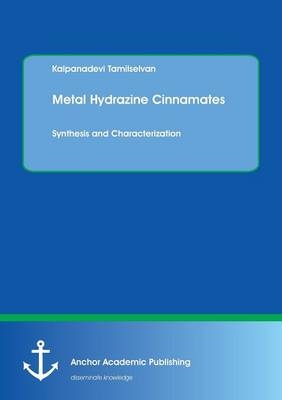
Metal Hydrazine Cinnamates
Anchor Academic Publishing (Verlag)
978-3-96067-034-6 (ISBN)
Dr.K. Kalpanadevi, MSc., MPhil., Ph.D., is serving as Assistant professor in the Department of Chemistry, Kongunadu Arts and Science College, Coimbatore, Tamilnadu, India. To date, he has a teaching experience of nine years and a research experience of six years. His areas of specialization include coordination chemistry and nanomaterial chemistry. He has published 23 papers in international journals so far, many of them having a number of citations.
'Text sample:
Chapter 2.3. Physico-chemical techniques:
The instrumental techniques used in the present study are, Infrared spectroscopy (IR), Thermo Gravimetry-Differential Thermal Analysis/Differential Scanning Calorimetry (TG-DTA/TG-DSC), Scanning Electron Microscopy (SEM) and Energy Dispersive X-Ray Analysis (EDX).
2.3.1 Infrared spectral analysis:
The infrared spectrum of a molecule is considered to be its unique and characteristic physical property. The basic interpretation of an IR spectrum leads to the characterization and identification of the sample. The IR spectrum is formed as a consequence of the absorption of electromagnetic radiation at frequencies that correlate to the vibration of specific sets of chemical bonds from within a molecule. Bonds with different bond lengths, strength, bending and torsional characteristics absorb different wavelengths of IR radiation, and the absorption maxima maybe characteristics of the types of linkages present; the absorption generally occurs in the 4000-400 cm-1 region of the spectrum.
Infrared radiation is capable of affecting both rotational and vibrational energy levels in the molecules [212, 213]. Some molecular vibrations are characteristic of the entire molecule, whereas others are associated with certain functional groups. IR spectra of solids are usually complex with a considerable number of peaks, each corresponding to a particular vibrational transition. Since a complete assignment of all the peaks to the specific vibrational modes is possible, straight forward identification of specific functional groups, covalently bonded linkage such as hydroxyl groups, trapped water, oxyanions, carbonates, nitrates, sulphates etc., and the modes of binding of the ligand to the metal ion can be made. As such, infrared spectroscopy has become an important technique in the elucidation of the structure of organic compounds and metal complexes. Plots of IR spectra show the frequency or wave number of incident radiation on the x-axis and percentage of transmittance on the y-axis. The wave number unit is used more often since it is directly proportional to the energy of vibration and such modern IR instruments are linear in cm-1 scale.
In the present study, the IR spectra of all the complexes were recorded by the KBr disc techniques using Perkin Elmer 597/1650 spectrophotometer.
2.3.2. Thermogravimetric analysis (TGA):
The thermal analysis is a technique in which the physical and chemical transitions of a substance are recorded as a function of temperature. In thermogravimetric analysis (TGA), the mass of the sample is recorded continuously as a function of temperature. TGA curves are specific for a given compound or system due to the unique sequence of physiochemical reactions that occur at definite temperatures and at rates controlled by the molecular structure. Changes in the mass of the sample take place as a result of the rupture and formation of various chemical bonds at higher temperatures, which leads to the evolution of volatile products or formation of reaction products.
In present study, the simultaneous TG-DTA experiments were carried out in Shimadzu DT40, Stanton 781 and STA 1500 thermal analyzers. Thermal analyses were carried out in air at the heating rate of 10°C per minute using 5-10 mg of the samples. Platinum cups were used as sample holders and alumina as reference. The temperature range was ambient to 700°C.
TG-DSC was performed using the Universal V4.5A TA Instrument in a temperature range of 50-700 °C with a heating rate of 20 °C/min.
2.3.3. Scanning Electron Microscopy (SEM) - Energy Dispersive X-ray analysis (EDX):
SEM is another powerful technique used to study the morphology (surface structures) of nanoparticles. SEM is able to provide 3-dimensional images of the objects, since it does not record the electrons passing thorough the specimen; on the other hand, it r
| Erscheinungsdatum | 18.06.2016 |
|---|---|
| Sprache | englisch |
| Maße | 155 x 220 mm |
| Gewicht | 178 g |
| Themenwelt | Naturwissenschaften ► Chemie ► Anorganische Chemie |
| Schlagworte | Cinnamic Acid • Coordination Chemistry • Hetero Bimetallic Hydrazine Cinnamate • Hetero Triimetallic Hydrazine Cinnamate • Hydrazine • Inorganic Chemistry • Transition metal |
| ISBN-10 | 3-96067-034-6 / 3960670346 |
| ISBN-13 | 978-3-96067-034-6 / 9783960670346 |
| Zustand | Neuware |
| Haben Sie eine Frage zum Produkt? |
aus dem Bereich


